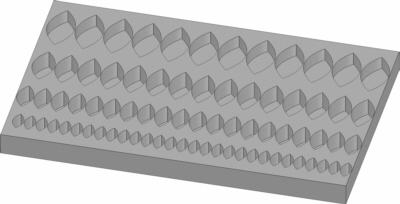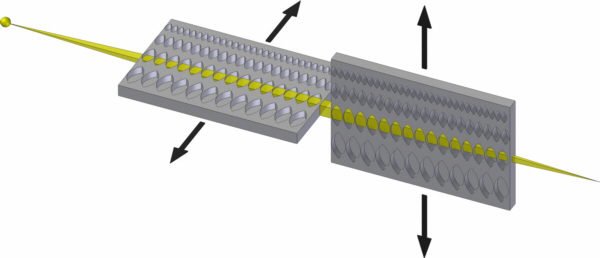CRLs can be made by reactive ion etching (RIE) of holes into a silicon wafer [e.g. Ari 2000, Sch 2005] or diamond substrate [Nöh 2003]. The holes have to have a parabolic geometry to avoid spherical aberration of the lenses. All lens elements on a wafer are made in one lithography step, so the alignment of the lens elements is not a problem. Today the width of the line focus achieved with these lenses is in the range below 30 nm.

Fig. 1: Sketch of a lens plate with four different line focus CRLs etched in a silicon wafer
As the RIE-process only provides holes perpendicular to the surface of the substrate, it is not possible to make CRLs with a point focus on one lens plate. A point focus can never the less be achieved by using two lens plates aligned one perpendicular to the other on two separate stages. In this arrangement, the horizontal and the vertical focal lengths can be chosen separately by shifting the corresponding lens plate to another lens row.

Fig. 2: Two lens plates can be used on two alignment stages to form a point focus CRL
| [Ari 2000] | V. Aristov, M. Grigoriev, S. Kuznetsov, L. Shabelnikov, V. Yunkin, T. Weitkamp, C. Rau, I. Snigireva, A. Snigirev, M. Hoffmann and E. Voges, X-ray refractive planar lens with minimized absorption, Appl. Phys. Lett., vol. 77, p. 4058, DOI: 10.1063/1.1332401, 2000 |
| [Nöh 2003] | B. Nöhammer, J. Hoszowska, A. K. Freund and C. David, Diamond planar refractive lenses for third- and fourth-generation X-ray sources, J. Synchrotron Rad., vol. 10, p. 168, DOI: 10.1107/S0909049502019532, 2003 |
| [Sch 2005] | C. G. Schroer, O. Kurapova, J. Patommel, P. Boye, J. Feldkamp, B. Lengeler, M. Burghammer, C. Riekel, L. Vincze, A. van der Hart, and M. Küchler, Hard x-ray nanoprobe based on refractive x-ray lenses, Appl. Phys. Lett. 87, 124103, 2005 |


